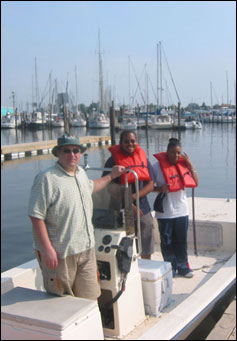 Undergraduate
Research Experience in Ocean and Marine Science
Undergraduate
Research Experience in Ocean and Marine ScienceDolphin Presence/Absence Probabilities on the Virginia and North Carolina Coasts as Correlated with Sea Surface Temperature and Chlorophyll-A Levels
 Purpose
Purpose
The
purpose of this research was to determine if sea surface temperatures
and chlorophyll
alpha can be used in determining the presence or absence of dolphins.
This would enable individuals to locate dolphins without having to physically
be on the water looking for them. Because of the Marine
Mammal Protection Act of 1972, the Navy is seeking more efficient
ways to locate dolphins in order to avoid future
harassment.
Location
of Research
The area that was
surveyed was the Elizabeth River. This river was chosen because of the
heavy amount of traffic that involves the military, recreational and
industrial sectors. Another contributing factor in using the Elizabeth
River is that there were little to no current data to be found involving
the area as far as the research was concerned.
General
Procedures to Obtain Results
The research
started with a lecture about dolphins in general and what the research
would entail through a PowerPoint presentation. A few days after the
presentation, four voyages were made along a specific transect of the
Elizabeth River. When that was accomplished, the archival data collected
by previous groups working on similar projects was investigated and
utilized. Their data of sightings were used in conjunction with the
sea surface temperature and chlorophyll alpha data for each week of
sightings. The sea surface temperature and chlorophyll alpha data was
found on various resources available online, such as the Rutgers
University Coastal Ocean Observatory Laboratory (COOL) and the SeaWiFS
Project site. Afterwards, the initial results were placed into graphs
with their corresponding themes. To determine the significant difference
of the data, the initial results were subjected to the T-test. With
the values from the T-test, the final results were obtainable and helped
to lead the way to the proper conclusions.





